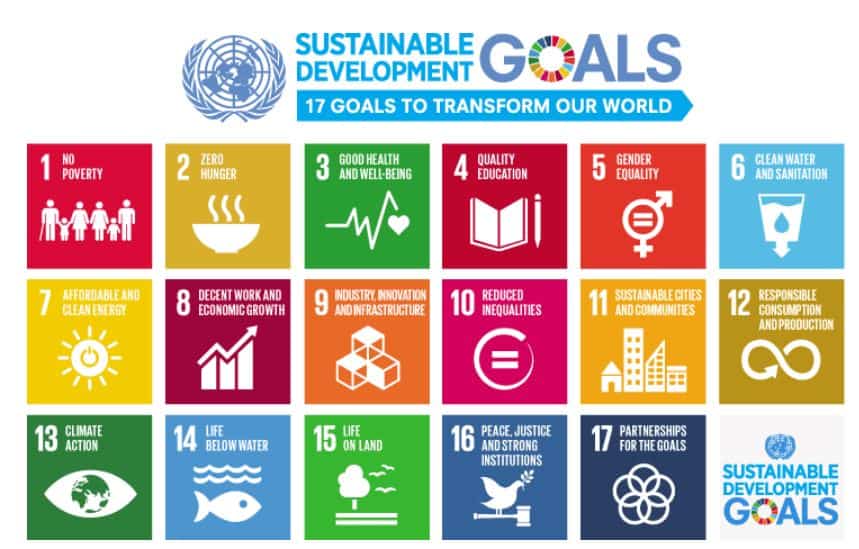UPSC Articles
Governance
Topic: General Studies 2:
- Government policies and interventions for development in various sectors and issues arising out of their design and implementation.
- Issues relating to development and management of Social Sector/Services relating to Health, Education, Human Resources.
Top Three SDGs & India
Context: President Donald Trump applauded India’s achievements during his speech in Motera stadium in Ahmedabad.
The top three Sustainable Development Goals (SDGs) of the United Nations are namely poverty elimination (SDG-1), zero hunger (SDG-2), and good health & well-being (SDG-3) to be attained by 2030

Daily Current Affairs IAS | UPSC Prelims and Mains Exam – 3rd March 2020
Pic Source: UNO
India’s Present status with regard to these three goals:
- The World Bank’s estimates of extreme poverty — measured as $1.9/per capita/per day at purchasing power parity of 2011 — show a secular decline in India from 45.9% to 13.4% between 1993 and 2015.
- If the overall growth process continues as has been the case since, say, 2000 onwards, India may succeed in eliminating extreme poverty by 2030.
- National Food Security Act (NFSA) that subsidises grains to the tune of more than 90% of its cost to 67% of the population can help India attain the goal of zero hunger before 2030
- The real challenge for India, however, is to achieve the third goal of good health and well-being by 2030
Poor Health condition in India (as per NFHS- In 2015-16)
- Almost 38.4% of India’s children under the age of five years were stunted
- 35.8% of children (below 5 years) were underweight (low weight for age)
- 21% of children (below 5 years) suffered from wasting (low weight for height)
- Also, the Global Hunger Index (GHI) ranks India at 102 out of 117 countries in terms of the severity of hunger in 2019.
- Slow Progress: The decadal decline in underweight children from 42.5% in 2005-06 to 35.8% in 2015-16 amounts to less than 1 per cent decline per year.
- Behind Other Nations: According to the Global Nutrition Report, 2016, at the present rates of decline, India will achieve the current stunting rates of China by 2055
What are the governments ambitions w.r.t malnutrition?
- The National Nutrition Strategy, 2017, aims to reduce the prevalence of underweight children (0-3 years) by 3% points every year by 2022 from NFHS 2015-16 estimates.
- Under National Nutrition Mission (renamed as POSHAN Abhiyaan), 2017, government aims to reduce
- Stunting by 2% per annum,
- Undernutrition by 2% per annum,
- Anemia (among young children, women and adolescent girls) by 3% per annum
- Low birth weight by 2% per annum
In order to achieve good Health, government has to focus on below four areas
- Mother’s education.
- It is one of the most important factors that has a positive multiplier effect on child care and access to healthcare facilities.
- It also increases awareness about nutrient-rich diet, personal hygiene, etc.
- This can also help contain the family size in poor, malnourished families.
- Thus, a high priority to female literacy, in a mission mode through liberal scholarships for the girl child, would go a long way towards tackling this problem.
- Access to improved sanitation and safe drinking water.
- The Swachh Bharat Abhiyan should shift its focus from mere ODF declaration to ODF+ and ODF++ strategies which involves proper functioning of community toilets, efficient waste sludge management and recycling measures.
- Jal Jeevan Mission which aims to provide piped drinking water to all Households by 2024 needs to be implemented in mission mode
- Change in dietary patterns
- There is a need to shift dietary patterns from cereal dominance to the consumption of nutritious foods such as livestock products, fruits and vegetables, pulses, etc.
- But they are generally costly and their consumption increases only by higher incomes and better education.
- Diverting a part of the food subsidy on wheat and rice to more nutritious foods can help
- New agricultural technologies
- India must adopt new agricultural technologies of bio-fortifying cereals, such as zinc-rich rice, wheat, iron-rich pearl millet
- The Indian Council of Agricultural Research (ICAR) has to work closely with Farmer Producer Organisations and NGOs so as to make newer seeds and modern farm practices affordable and accessible to all farmers in the country.
Conclusion
- Global experience shows that with the right public policies focusing on agriculture, improved sanitation, and women’s education, one can have much better health and well-being for its citizens, especially children. India can certainly do better, but only if it focuses on this issue.
Connecting the dots
- 17 Sustainable Development Goals
- India’s achievements in Millennium Development Goals
- India’s Ayushman Bharat Programme














